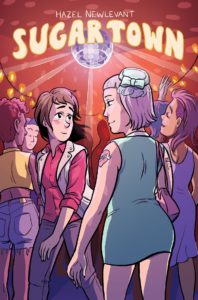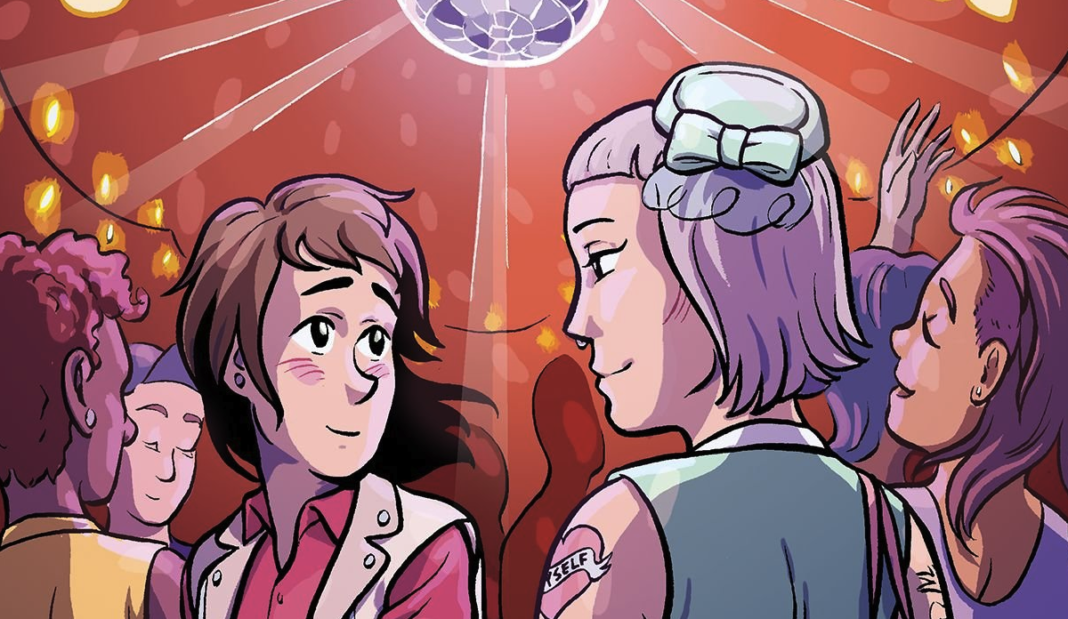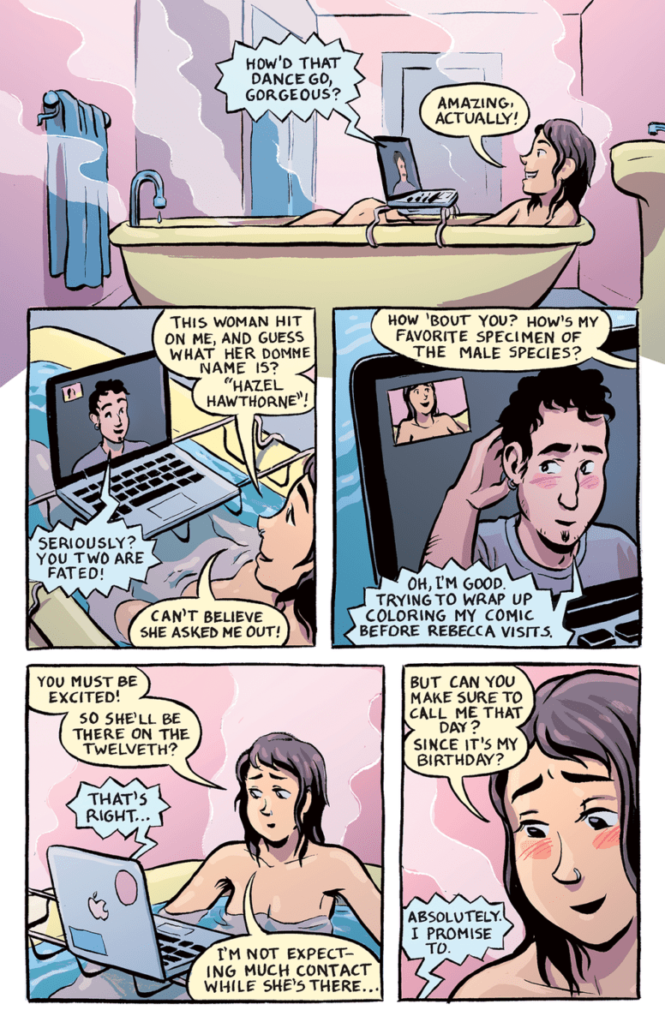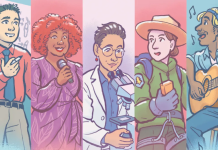Welcome to Queerness in Comics, a bi-weekly column by Avery Kaplan, which will explore queer representation and themes in comics. This week, Avery is exploring Sugar Town, originally published in 2017.

Before you’ve even made it to the title page of Sugar Town, you’ll notice the lovely art on the inside of the cover: portraits of Argent and Gregor, Hazel’s two love interests in the story. The portraits are presented in a manner that incorporates multiple images of both of them and interlocks those images with one another.
This pattern is a visual representation of the way these two love interests are presented in the story: neither love interest is given preferential treatment (even though the comic is mostly about Hazel’s introduction to and budding romance with Argent), and there is no hierarchical assessment of which love interest is “preferred” to one another – Hazel simply has feelings for both of them.
For some readers, this might be the first time they have seen polyamory presented in a positive way. It is not uncommon in popular media for polyamorous relationships to be presented as either a punch line, or perhaps worse still, as an unstable situation that must be “resolved” by the conclusion of the narrative. In many cases, people who have never knowingly met someone in a polyamorus relationship, much less had any measure of firsthand experience with one, write these sorts of stories.
This lack of experience is certainly not the case with Newlevant. Like their graphic memoir No Ivy League, Sugar Town is based on their personal experiences – the comic is even dedicated to “the real” Gregor and Argent. While the romantic story may appear to have a fairy tale ending, where everyone lives happily ever after, this isn’t a fabricated story meant to sugar-coat polyamory – it’s an account of Newlevant’s actual experiences.
It isn’t just the fact that Hazel balances romance with two different characters that’s important, but also the fact that the romantic interests are different genders. Another common misconception in stories about bisexual characters is that their attraction to a certain gender must somehow be disingenuous.
This is never a concern in Sugar Town. As mentioned above, the majority of the story focuses on the budding romance between Argent and Hazel. Hazel’s only communication with Gregor, with whom she is already romantically involved at the outset of the story, takes place over video chat or phone call. During these scenes, some important information is imparted, including the fact that Gregor is also seeing other partners. However, the story also makes a point of showing the reader that Hazel and Gregor share genuine attraction with one another, with Hazel flirtatiously flashing Gregor, and talking with him about her interest in Argent. The depiction of meaningful communication between two partners as one of them considers courtship with a new partner is an important element of Sugar Town, and one that is frequently left out of less informed depictions of polyamory.
Which isn’t to say that Hazel doesn’t experience doubt over the course of the comic. On her birthday, she wakes up and finds that Gregor has yet to leave a message on her Facebook wall, which makes her feel slightly jealous, wondering if he’s too busy with his other romantic interest. However, he calls her just a few minutes later, they both discuss their feelings of jealous, talking through the concern rather than allowing it to fester. It’s an essential reminder of how important communication is to the survival of a polyamorous relationship.
Another important scene in Sugar Town sees a flogging session involving Hazel and Argent are interrupted when Hazel pulls something. This is the sort of mundane experience that happens in reality: sometimes, romance is interrupted, rather than taking the form of unrealistic, unblemished reality. Of course, Hazel’s pulled muscle also gives Argent the chance to deliver some world-class aftercare, and these sweet moments only serve to endear her even more to Hazel (and to the readers).
At the conclusion of the story, Hazel is romantically involved with both Argent and Gregor. As Hazel takes a cross-country flight and heads home, the future of both relationships is left open, but full of possibility and promise. It’s an extremely hopeful and positive ending, and one that does not lean toward one partner or the other, but instead remains balanced.
An essential part of the efficacy of Newlevant’s storytelling is their artwork. In addition to the excellent use of color, which is vibrant and inviting throughout, they are especially skilled at depicting the emotions of the characters through facial expressions. Furthermore, Argent’s tattoos – both kneecaps have bees tattooed on them, and a heart on her arm bears a banner that reads “myself” – instantly communicate volumes about the character without a single word being uttered.









